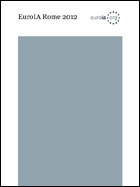“The dirty magnet” - Gerry McGovern at EuroIA
I’m at EuroIA in Rome, and will be trying my usual blog-it-as-it-happens approach. Whilst also putting the final touches to my talk on “IA in the touchscreen era” tomorrow. Here are my notes on the opening session from Gerry McGovern...

EuroIA Rome 2012
by Martin Belam
All of my notes from the 2012 EuroIA conference in one ebook, featuring coverage of talks by Gerry McGovern, Peter J. Bogaards, Andrea Resmini, Eric Reiss, Jim Kalbach, Carola Weller, Sara Wachter-Boettcher and Stephen P. Anderson
Available free for iBooks, for Kindle, and as a PDF
“The dirty magnet” - Gerry McGovern
“One thing I’ve learnt from working on the web: Often the things that we think work, don’t work. And the things we think won’t work, do work.” - Gerry McGovern, EuroIA
Gerry was talking about giving users what looked like an irritating over-complicated survey, where they have to rate the five most important things they want to do on a website. At first glance it looks like nobody would ever fill in the form, but wherever they’ve tried it, it is great for sorting out what Gerry terms the “top tasks”. A relatively small amount of tasks always have a huge demand, and vastly outweigh the votes for what Gerry calls “tiny tasks”.
The “dirty magnets” in the title of Gerry’s talk were a type of navigation that pulls people away from where they really wanted to go, because it falsely drew them away with a vague promise. It happens, he says, because in any organisation everyone has loads of tasks that need doing. A small number dominate, but there are hundreds of “tiny tasks” disrupting the most important things. Sometimes these “tiny tasks” even get elevated to “top task” status because they get supported by senior managers who think they are really important thing for customers to do.
In a great IA, Gerry says, a link says “This is what I am”, but equally it also says “This is what I’m not.”
He illustrated his point with a great set of mock-ups of road signs, where a really simple choice at a junction becomes an information overload nightmare as more elements are added included such unhelpful terms as “Frequently visited cities”. The trouble is, he said, “we keep adding these little elements to try and fix the problems we should have addressed in the first place” in the primary navigation. If you’ve added a “Most popular” section to your homepage, you’ve admitted that the other stuff isn’t popular and is wasting space.
Gerry argues that people always assess an architecture with a specific task in mind - giving the example of trying to update his MX records at an anti-spam website. The primary navigation categories of “Learn more”, “FAQ” and “Support” hinted that they might help. But they didn’t. Very frustrating for the customer.
How do we get away from the dirty magnet?
Gerry’s survey technique was one answer. It allowed the organisation to really hone the main tasks in the navigation around the primary things that users wanted to do. Gerry also believed in the value of a content cull. He cited an example of Liverpool Council in the UK, who reduced their content pages from 4,000 to 7,00. They got four complaints from the public, and lots of complaints from inside the organisation. Customer satisfaction improved, in fact Gerry suggested that “deleting about 80% of your content leads to a 100% increase in sales and conversions, because content gets in the way of conversion” - of course, like effective advertising spend, the trick is to know which 80%...
Gerry argued that classical advertising is in retreat on the modern web. If you put a search for “New York Dublin flight” into Google, he said, then you are the advertiser. We need to respond to the customer’s ad that they have put on the web. The model of advertising for awareness, distracting, or changing your mind is shot on the web. When was the last time you went on the web to buy flights between New York and Dublin, and ended up buying golf clubs?
Gerry also had a great quote about the diminishing value of the homepage, and the kind of elements we tend to continue to design for them:
“We keep doing big banners on our homepages because someone in the 1970s was trained to design billboards for the highway, and we think we can get attention that way.”
Next...
I’ll have some more notes from other sessions today as and when I get them finished, starting with Peter J. Bogaards discussing “wicked problems”.
This is one of a series of blog posts about the talks I saw at EuroIA 2012 in Rome. You can download the whole lot in an ebook for iBooks, for Kindle or as a PDF
“The dirty magnet” - Gerry McGovern
“Helping businesses to tackle a ‘wicked problem’” - Peter J. Bogaards
“Process & People” - Birgit Geiberger & Peter Boersma
“An agronomist’s unexpected path to UX Design” - Raffaella Roviglioni
“Responsive IA: IA in the touchscreen era” - Martin Belam
“‘Stupid bloody system!’: Bad IA in the workplace” - Jonas Söderström
“On beauty” - Andrea Resmini & Eric Reiss
“RITE: Testing and a business driver” - Jim Kalbach & Carola Weller
Building a coupon app for iPhone - Hermann Hofstetter & Gregor Urech
“Micro IA and content that travels” - Sara Wachter-Boettcher
“What am I curious about?” - Stephen P. Anderson
You can also download all my notes from the previous EuroIA in Prague as one PDF or as an ePub document.
